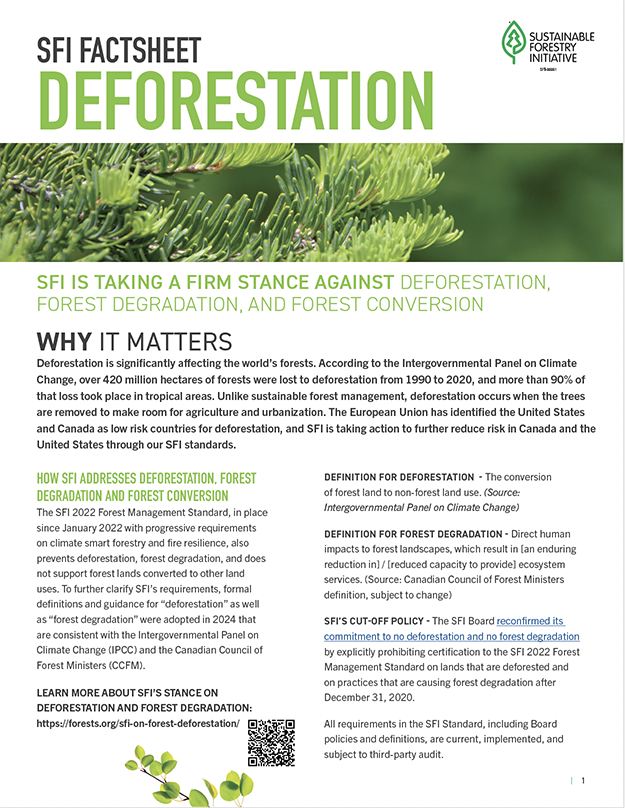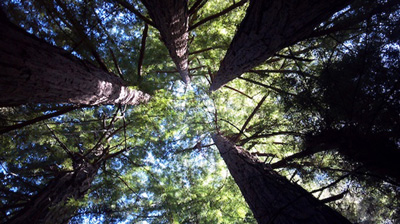SFI is TAKING A FIRM STANCE AGAINST DEFORESTATION/FOREST DEGRADATION
SFI, along with others worldwide, shares the commitment of ensuring forests remain as healthy and resilient forests. The SFI Forest Management Standard does not allow deforestation and has strong requirements to prevent forest degradation. The SFI Fiber Sourcing and SFI Chain of Custody Standards also have requirements to ensure SFI-certified organizations avoid sourcing from controversial sources, which includes conversion sources originating from regions experiencing forest area decline.
The SFI Forest Management Standard, in place since January 2022, prevents deforestation, forest degradation, and does not support forest lands converted to other land uses. Given increasing customer and government demand, we have adopted formal definitions for “deforestation” as well as “forest degradation” that are consistent with the Intergovernmental Panel on Climate Change (IPCC) and the Canadian Council of Forest Ministers (CCFM). These new definitions are mandatory for our SFI Forest Management Standard. Additional guidance was developed to demonstrate the link between the new definitions and SFI standard requirements. In addition, the SFI Board adopted a cut-off date policy of December 31, 2020 which aligns with SFI’s commitment to no deforestation and no forest degradation. All requirements in the SFI Standard are subject to third-party audits.
SFI Policy on No Deforestation, No Forest Degradation, and No Conversion of Natural Forests to Plantation Forests
Since 2015 the SFI Forest Management Standard prohibits deforestation and forest degradation through multiple requirements in the Standard.
The SFI Board reconfirmed its commitment to no deforestation and no forest degradation on March 20, 2024, by explicitly prohibiting certification to the SFI 2022 Forest Management Standard on lands that are deforested and on practices that are causing forest degradation after December 31, 2020.
In the spirit of rehabilitating degraded lands and/or non-forest lands to sustainably managed forests, certification to the SFI 2022 Forest Management Standard is allowed, as long as the current SFI certified organization did not cause the deforestation, and is rehabilitating the lands, and is meeting the requirements of the SFI 2022 Forest Management Standard.
In addition, the SFI 2022 Forest Management Standard does not permit the conversion of natural forests to plantation forests. On May 20, 2025, the SFI Board prohibited the conversion of natural forests to plantation forests after December 31,2020. This is supported by:
- SFI’s definitions of Plantation Forest, Semi-Natural Planted Forest, and Native Forest. Notably, SFI’s definition of native forests aligns with definitions of natural forests used by other organizations.
- Requirements within the SFI 2022 Forest Management Standard that collectively ensure planted forests are regenerated in ways that prevent them from exhibiting the characteristics of a plantation forest
Definitions:
While the SFI Forest Management Standard has strong requirements to prevent forest degradation, definitions on “deforestation” as well as “forest degradation” were added on March 20, 2024 to strengthen SFI’s position on these critical topics. Additional guidance was also adopted to link the new definitions to SFI standard requirements.
DEFORESTATION
- The conversion of forest land to non-forest land use. (Source: Intergovernmental Panel on Climate Change)
FOREST DEGRADATION
- Direct human impacts to forest landscapes, which result in [an enduring reduction in] / [reduced capacity to provide] ecosystem services. (Source: Canadian Council of Forest Ministers definition, subject to change)
At its March 20, 2024, meeting, the SFI Board approved using a CCFM definition
SFI FOREST MANAGEMENT Standard Prevents Deforestation
The SFI Forest Management specifies SFI’s commitment to no-deforestation, indicating that “Forest lands converted to other land uses shall not be certified to this SFI Standard” through Performance Measure 1.3. These restrictions are intended to apply to the conversion of forest land and recently deforested land that is capable of regenerating to forest but is preventing from doing so. Furthermore, if a SFI certified organization plans to convert one forest cover type to another forest cover type, they must conduct an assessment of the potential ecological impacts to ensure it does not significantly impact Forests with Exceptional Conservation Values, old growth forest, and/or forest critical to threatened and endangered species. Additionally, Performance Measure 2.1 requires that, « Certified Organizations shall promptly reforest after final harvest. »
SFI FOREST MANAGEMENT Standard Prevents Forest Degradation
The SFI Forest Management Standard prevents forest degradation through five core areas which act to limit lasting and significant direct anthropogenic impacts to the structure, composition, or function of the forest. Below are those areas and the key requirements of the SFI Forest Management Standard.
1. PRODUCTIVITY (e.g., growing stock, non-timber forest products)
- Prompt forest regeneration after harvest: Performance Measure (PM) 2.1.
- Maintenance of forest soils and stocks: PM 2.3.
2. BIOLOGICAL DIVERSITY (e.g., ecosystem state, forest fragmentation, species, species functional groups)
- Protection and maintenance of native biodiversity: PM 4.1.
- Conservation of species at risk and rare communities: PM 4.2.
- Identification and protection of ecologically important sites: PM 4.3.
3. DISTURBANCES (e.g., alien invasive species, fire, water quantity)
- Protection of water values: PM 3.2.
- Avoidance of negative effects of biological agents: PM 2.4.
- Limitations of forest degradation from wildfire and restore forest post-wildfire: PM 10.1.
4. CARBON STORAGE
- Enhancement of opportunities for carbon capture on forests that are owned or managed: PM 9.2.
5. PROTECTIVE FUNCTIONS (e.g., soil erosion, water quality)
- Maintenance of forest soils and stocks: PM 2.3.
Protection of water values: PM 3.2.
Furthermore, SFI Performance Measure 1.2 lays out specific constraints on conversion of one forest cover type to another forest cover type, which in turn also prevents forest degradation. In particular, PM 1.2 precludes conversion of one forest cover type to another forest cover type in the absence of objectives for long-term outcomes that support maintaining native forest cover types and ecological function. This includes where conversion puts rare; ecologically important, native forest cover types at risk of becoming rare, or where conversion creates significant adverse impacts on Forests with Exceptional Conservation Value, old growth forests, or forests critical to threatened and endangered species.
SFI Modules to Support EUDR Due Diligence
The SFI 2022 Fiber Sourcing Standard and the SFI 2022 Chain of Custody Standard already require SFI-certified organizations to assess the risk of sourcing forest fiber from controversial sources including from conversion sources originating from regions experiencing forest area decline. If a SFI-certified organization determines they are sourcing from such sources, they will need to mitigate this risk of sourcing this forest fiber.
With the European Union Deforestation Regulation (EUDR) accelerating these global conversations, it’s also important SFI offer tools for those organizations looking to support EUDR due diligence requirements. In March 2024, SFI introduced the SFI Fiber Sourcing Module to Support EUDR Due Diligence Requirements developed for companies certified to the SFI 2022 Fiber Sourcing Standard. SFI also published the SFI Chain of Custody Module to Support EUDR Due Diligence Claims. This Module is for organizations certified to the SFI 2022 Chain of Custody Standard. Because these modules were developed to support EUDR’s due diligence requirements, the modules integrate EUDR definitions as well as EUDR’s due diligence system requirements. SFI-certified organizations can add these module to the scope of their existing SFI Fiber Sourcing or SFI Chain of Custody certifications.
The European Union has identified the United States and Canada as “low risk” countries for EUDR, and this of course is where forests are certified to the SFI Forest Management Standard. For a complete list of low-risk countries visit the EU website.
The SFI Fiber Sourcing Module to Support EUDR Due Diligence requires a geolocation solution in order to meet the requirements of the EUDR. SFI leaves it up to the organization to choose their preferred geolocation technology solution and provider. Finally, some SFI certified organizations will not need to use the optional SFI Modules to meet EUDR requirements, as they might have their own systems in place to provide the assurances.
Modules are a way for SFI to address emerging issues of benefit to SFI certified organizations by creating certification requirements to address the specific market need. SFI-certified organizations can scope these additional requirements into their existing SFI Standard certification and add the scope to their existing audit. The audit certificate will acknowledge the organization has met the additional requirements of what the module is intended to address. Modules are optional for those who voluntarily choose to use it.
SFI FOREST MANAGEMENT STANDARD
SFI FIBER SOURCING STANDARD
SFI ON DEFORESTATION/FOREST DEGRADATION
SFI CHAIN-OF-CUSTODY STANDARD
SFI CERTIFIED SOURCING STANDARD
SFI INDIGENOUS PEOPLES AND FAMILIES MODULE
SFI SMALL LANDS GROUP CERTIFICATION MODULE
SFI 2022 STANDARDS AND RULES (COMPLETE)
INTERPRETATIONS ON THE SFI 2022 STANDARDS AND RULES
SFI 2022 STANDARDS AND RULES REVISION PROCESS
CONFLICT TIMBER — RUSSIA AND BELARUS
Labels and Certification
Zachary Wagman
Senior Manager, Market Access
Tel: 613-745-3706
Standards
Gregor Macintosh
Senior Director, Standards
Tel: 778-351-3358
Program Participant Relations & SICs
Gordy Mouw
Director, Network Relations
Tel: 715-220-4132
Customer Affairs & Branding
Jason Metnick
Senior VP, Customer Affairs
Tel: 602-374-6539
Rachel Dierolf
Senior Director, Technical Operations & Reporting
Tel: 613-274-0124
Jeffrey Ross
Director, Indigenous Forest Certification
Tel: 208-410-0773
FEATURED ARTICLE
NEW FOREST CERTIFICATION STANDARDS OFFERS NATURE-BASED SOLUTIONS TO THE CLIMATE CRISIS
The Sustainable Forestry Initiative’s (SFI) updated forest certification standards provide solutions to some of the world’s most pressing sustainability challenges. Sustainable forest management and the procurement of wood products from sustainably managed sources are critical tools that help avoid deforestation.








